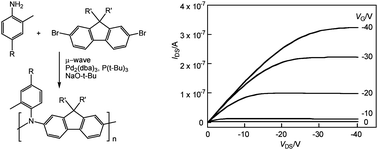Triarylamine polymers by microwave-assisted polycondensation for use in organic field-effect transistors†
Abstract
Triarylamine

* Corresponding authors
a
Organic Materials Innovation Centre, School of Chemistry, The University of Manchester, Oxford Road, Manchester, UK
E-mail:
michael.turner@manchester.ac.uk
Fax: (+44) 0161 275 4273
b
Polymer Science and Engineering Group, School of Materials, The University of Manchester, Grosvenor St., Manchester, UK
E-mail:
brian.saunders@manchester.ac.uk
c School of Electrical and Electronic Engineering, The University of Manchester, Manchester, UK
Triarylamine

 Please wait while we load your content...
Something went wrong. Try again?
Please wait while we load your content...
Something went wrong. Try again?
M. Horie, Y. Luo, J. J. Morrison, L. A. Majewski, A. Song, B. R. Saunders and M. L. Turner, J. Mater. Chem., 2008, 18, 5230 DOI: 10.1039/B808840C
To request permission to reproduce material from this article, please go to the Copyright Clearance Center request page.
If you are an author contributing to an RSC publication, you do not need to request permission provided correct acknowledgement is given.
If you are the author of this article, you do not need to request permission to reproduce figures and diagrams provided correct acknowledgement is given. If you want to reproduce the whole article in a third-party publication (excluding your thesis/dissertation for which permission is not required) please go to the Copyright Clearance Center request page.
Read more about how to correctly acknowledge RSC content.
 Fetching data from CrossRef.
Fetching data from CrossRef.
This may take some time to load.
Loading related content
